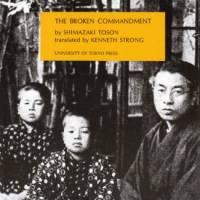A classic from 1906, Toson Shimazaki's "The Broken Commandment" follows the ideological struggles of a young teacher, Ushimatsu Segawa.
The Broken Commandment, by Toson Shimazaki, Translated by Kenneth Strong.
249 pages
UNIVERSITY OF TOKYO PRESS, Fiction.
Born into the ostracized burakumin caste but hiding his origins by following a commandment of his father, Ushimatsu finally confronts his own hypocrisy to challenge society's discrimination after meeting his personal hero, a fellow burakumin who publicly campaigns against prejudice. The humanist subject matter, daringly expressing outrage for the derided class in a period when they were still subject to widespread injustice, made Shimazaki an instant, if controversial, success in literary Japan.
Shimazaki started his career as a poet, and was influenced by 19th-century Western writers like Tolstoy, Ibsen, and Flaubert. He deliberately set out to write a humanist, realistic novel and was inspired by the real-life story of an famous burakumin educator, Isokichi Oe. The novel is more than a protest to discrimination, however. In revealing the tormented doubts, intelligent inner conflict and ultimate compassion of Ushimatsu, from his friendship with an alcoholic colleague to his relationships with his mentor, peers and students, Shimazaki provides a coming-of-age story from early 20th-century Japan.
Set in the beautiful mountains of Nagano, young Ushimatsu fully enters adulthood by renouncing his own duplicity to proclaim his — and all humans' — rights to an equal chance at happiness.
Read archived reviews of Japanese classics at jtimes.jp/essential.



